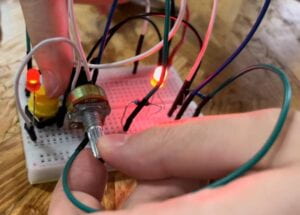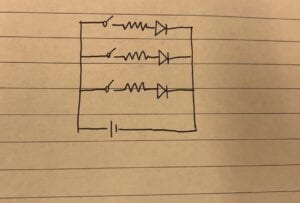FOR TASK 1:
step1:
With this complete circuit, the buzzer will beep when the button is pressed.

step2:
After adding a parallel circuit, the LED will light up and the buzzer will beep at the same time. My partner and I made a mistake on our first trial, adding the button to the branch circuit thus making the buzzer to beep non-stop.

step3:
The final work includes three parallel circuits. If the button is being pressed, two LED will light up and the buzzer will beep at the same time.

FOR TASK 2:
We built the switch using cardboard, copper tape, and wires. First, I thought of connecting the wires and the copper tape using tape. Instead, we used hot glue gun to melt part of the wires to connect, because it made the connection more stable this way.

FOR TASK 3:
We replace the button with the switch, making it more convinient to type out the morse code.
Additional questions:
- The function of the resistor is to limit the current so the LED won’t be damaged.

- The circuit built today can “listen” to the action of the switch, “think” effectively using the current as the medium, and “speak” with beeps from the buzzer. But as effective as it may be, it only possesses low interactivity, for the action of the circuit is quite simple and doesn’t convey much meanings.
- Interactive design can harness the power from physical computing, using various interactive devices in order to make a imaginary design to become interactive art.